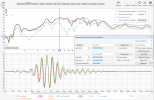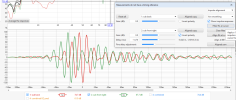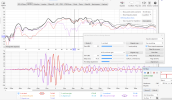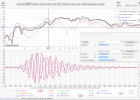One of my friends came over a few weeks ago to listen to my new DOS sub (that was placed in my home office system for testing purposes before being moved to my living room)
He loved it so much that he decided to build the same for his living room
Before venturing into this project we used one of his existing DIY DOS subwoofers (from his home theater system) to measure the best position for the future sub in the living room
Quickly we noticed that one sub will not be enough to optimize the full bass range so we identified two positions in the room that when combined shall provide pretty good results
This is his living room:

His MLP is in the middle of the couch
One of the new subs will be placed behind the couch, right behind his MLP (as shown in the below picture that was taken while doing the measurements in search for the best positions)

The front sub will be placed next to his front right speaker (where you see the cardboard box on the floor)

This is the response we got in the MLP when placing the above test sub behind the couch:

And this is the response when placing the test sub in the front:

This is the combined response:

And this is the predicted EQd result:

A significant amount of boost will be needed in the low end but it shall be fine since he listens at low to moderate SPL (the amps will be able to cope with that)
I am attaching the mdat file for those who are interested in all the graphs
So after he saw the graphs he got really excited (quite understandably) and started the build immediately
This is the design using the same Lavoce NBASS08-20 drivers (two per cabinet) that I used in my project

Each cabinet will be powered by a Fosi V3 Mono amp
When driven with 240W of power they shall each produce 95dB at 24Hz at 1 meter (=101dB for the two cabinets)

All this at 86% of the linear xmax

Here is how the build is progressing:



In the last picture you can already see the 'beauty front' from Ikea
The drivers shall arrive in one month's time, I will post an update then
Stay tuned!
He loved it so much that he decided to build the same for his living room
Before venturing into this project we used one of his existing DIY DOS subwoofers (from his home theater system) to measure the best position for the future sub in the living room
Quickly we noticed that one sub will not be enough to optimize the full bass range so we identified two positions in the room that when combined shall provide pretty good results
This is his living room:
His MLP is in the middle of the couch
One of the new subs will be placed behind the couch, right behind his MLP (as shown in the below picture that was taken while doing the measurements in search for the best positions)
The front sub will be placed next to his front right speaker (where you see the cardboard box on the floor)
This is the response we got in the MLP when placing the above test sub behind the couch:
And this is the response when placing the test sub in the front:
This is the combined response:
And this is the predicted EQd result:
A significant amount of boost will be needed in the low end but it shall be fine since he listens at low to moderate SPL (the amps will be able to cope with that)
I am attaching the mdat file for those who are interested in all the graphs
So after he saw the graphs he got really excited (quite understandably) and started the build immediately
This is the design using the same Lavoce NBASS08-20 drivers (two per cabinet) that I used in my project
Each cabinet will be powered by a Fosi V3 Mono amp
When driven with 240W of power they shall each produce 95dB at 24Hz at 1 meter (=101dB for the two cabinets)
All this at 86% of the linear xmax
Here is how the build is progressing:
In the last picture you can already see the 'beauty front' from Ikea
The drivers shall arrive in one month's time, I will post an update then
Stay tuned!










